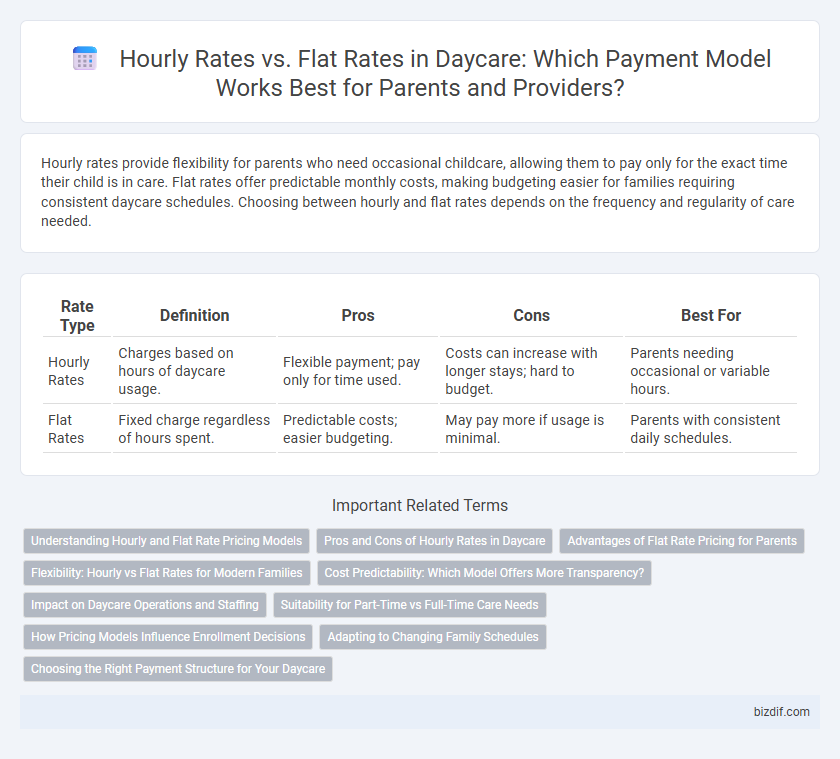Hourly rates provide flexibility for parents who need occasional childcare, allowing them to pay only for the exact time their child is in care. Flat rates offer predictable monthly costs, making budgeting easier for families requiring consistent daycare schedules. Choosing between hourly and flat rates depends on the frequency and regularity of care needed.
Table of Comparison
| Rate Type | Definition | Pros | Cons | Best For |
|---|---|---|---|---|
| Hourly Rates | Charges based on hours of daycare usage. | Flexible payment; pay only for time used. | Costs can increase with longer stays; hard to budget. | Parents needing occasional or variable hours. |
| Flat Rates | Fixed charge regardless of hours spent. | Predictable costs; easier budgeting. | May pay more if usage is minimal. | Parents with consistent daily schedules. |
Understanding Hourly and Flat Rate Pricing Models
Hourly rates in daycare pricing charge parents based on the exact number of hours their child attends, offering flexibility for part-time care and potentially lower costs for short visits. Flat rates provide a fixed fee regardless of hours, simplifying budgeting and ensuring consistent revenue for providers. Understanding these models helps parents balance cost and care needs while allowing daycare centers to optimize occupancy and financial stability.
Pros and Cons of Hourly Rates in Daycare
Hourly rates in daycare offer flexibility for parents needing occasional or variable care, allowing them to pay only for the exact time their child is enrolled. This pricing model can sometimes result in higher overall costs during extended care hours, making budgeting less predictable compared to flat rates. However, hourly rates promote fairness and transparency, ensuring families are charged proportionally to their usage, which can be beneficial for those with fluctuating schedules.
Advantages of Flat Rate Pricing for Parents
Flat rate pricing in daycare offers parents predictable monthly costs, simplifying budgeting and financial planning. This pricing model promotes consistent attendance by eliminating concerns about fluctuating hourly fees. Families benefit from greater convenience and peace of mind, knowing they pay a set amount regardless of daily usage variations.
Flexibility: Hourly vs Flat Rates for Modern Families
Hourly rates in daycare offer modern families the flexibility to pay only for the actual time their child spends in care, accommodating irregular schedules and part-time needs. Flat rates provide predictable monthly or weekly costs, which can simplify budgeting but might not reflect fluctuating attendance. Choosing between hourly and flat rates depends on a family's scheduling variability and financial planning preferences.
Cost Predictability: Which Model Offers More Transparency?
Flat rates provide greater cost predictability for daycare services by offering a set fee regardless of hours used, allowing parents to budget confidently without unexpected charges. Hourly rates may vary based on attendance, causing fluctuations in total expenses and less transparent monthly costs. Families prioritizing financial clarity often prefer flat rate plans, as they simplify expense management and eliminate surprises on billing statements.
Impact on Daycare Operations and Staffing
Hourly rates in daycare settings create flexible scheduling options but can lead to unpredictable staffing needs and potential payroll fluctuations. Flat rates provide consistent revenue streams, allowing for more stable staffing allocations and operational budgeting. Balancing these payment models directly influences employee workload management, retention, and overall service quality.
Suitability for Part-Time vs Full-Time Care Needs
Hourly rates offer flexibility for parents seeking part-time daycare, allowing payment only for the hours their child attends and often resulting in cost savings for irregular schedules. Flat rates provide consistent pricing suited for full-time care, ensuring fixed monthly or weekly expenses regardless of daily attendance fluctuations. Choosing between hourly and flat rates depends on the child's care requirements, with hourly rates best for occasional use and flat rates ideal for continuous, full-day enrollment.
How Pricing Models Influence Enrollment Decisions
Hourly rates in daycare offer flexibility for parents with irregular schedules, often attracting families seeking short-term or part-time care, while flat rates provide predictable monthly expenses favored by those needing consistent, full-time enrollment. Pricing models influence enrollment decisions by aligning with family budget constraints and time commitments, where transparent and competitive fees can increase trust and retention. Understanding these dynamics helps daycare centers optimize pricing strategies to balance occupancy and revenue stability.
Adapting to Changing Family Schedules
Daycares offering hourly rates provide flexible billing that adapts to fluctuating family schedules, accommodating varying drop-off and pick-up times without unnecessary charges. Flat rates simplify budgeting for families with consistent childcare needs, ensuring predictable monthly expenses despite occasional schedule changes. Integrating a hybrid pricing model empowers daycares to meet diverse family demands while maintaining operational efficiency.
Choosing the Right Payment Structure for Your Daycare
Choosing between hourly rates and flat rates for daycare payment structures depends on the frequency and duration of childcare needs. Hourly rates offer flexibility for irregular schedules and part-time care, allowing parents to pay only for the time used. Flat rates provide cost certainty and convenience for full-time daycare, often including additional services like meals and activities in a single payment.
Hourly rates vs flat rates Infographic

 bizdif.com
bizdif.com